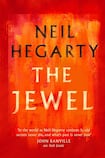
Sometimes – less than a handful of times in a lifetime – a summer comes along; so blazing as to burrow deep down inside of us – so full of the fact of simply being human as to leave an imprint; one that we hope never leaves us. If Neil Hegarty’s dazzling, raw and moving new book, The Jewel, were a summer, it would be one of those summers.
This striking book is set between Ireland, the UK and Europe – following the lives of three individuals, each with a tragic history of loss; tied together by the simple fact of having made it through.
The story – as full of the aching, inescapable truths of history as Inch Levels – is told in fragments; by an artist turned thief, a curator and a man charged with the recovery of the resplendent, fated art piece from the title. Narrative voice moves between the three characters with grace – staying with each; just long enough for a polished, fascinating tale to unfold.
Hegarty’s characters are survivors; he paints them with such a tender and honest stroke as to have us flinching; shifting uncomfortably as the past (individual, familial, national, imagined) unravels on them so devastatingly.
These characters are real – the stuff of blood and bone – and of so much else that makes us human; so the things they are forced to deal with are real, too. Nothing is too ugly, blood-soaked, dirt-stained or triggering to come under Hegarty’s dissection. Here is a writer comfortable in his task; not only showing us how well he sees the darkened corners of our society, but telling us that he wants – he needs – us to see them too.
Bones of life
And there is just so much to see: the relationship between women and men, women and women, men and men; no holds barred. The State and the church, entitlement and abuse, poverty and violence – abortion and racism, divorce and death – grief and suicidal thoughts; Hegarty bares the bones of life in a style both respectful and shattering.
The story is about a piece of stolen Victorian art but it is also about "all the sorrows that a body can bear". It's about roots and belonging, babies and bodies, borders and identity, home and history – the story is about healing; about how we find a way through.
Memory courses through The Jewel like water – at times a quiet, trickling stream, at others a wild and tumultuous ocean; often, though, it is a frozen river; only just beginning to thaw out. Childhood is shown in a very particular way; almost as a geographical mark on the maps of the lives of the characters – a place in which they experience unimaginable trauma; from which they had to remove themselves; in whatever way they could manage.
Despite the trauma that the painting carries in its wake, and the sorrow from which it was created – a form of healing is born from it too, somehow
The writing is lyrical and poetic – some paragraphs are so exquisite as to feel almost ethereal. The colours of the Thames shingle at low tide through the eyes of a young boy just before the horrific loss of his father, the tenderness shown from one tired man to another, the bond formed between two sisters by a glistening rock in the company of a donkey, friendship born out of shared grief; “safe ground” is found where it can be in this book.
Form of healing
The painting at the heart of the book is, in itself, a thing built of “many, many layers” – and, like our history, it has left a lasting mark; light still wells up from within. Despite the trauma that the painting carries in its wake, and the sorrow from which it was created – a form of healing is born from it too, somehow. More a heron from the silt than a phoenix from a flame (Hegarty leaves room for no form of cliche or romanticism) but this story is full of renewal and reshaping; of the hope born out of human goodness.
As I read this book, a helicopter filled the sky above the river Foyle in Derry, the hometown I share with Neil Hegarty. Violence and fear have crept back into the city; being forced into the great unknown of Brexit has rattled things that had – after decades of hard work – found a peaceful still point.
I found echoes here of Eavan Boland – of her “outsiders” – those ancestors that lie both beneath and inside of us; the burdens we have been forced to carry, and the suffering some of us still inflict upon each other.
“Under them remains
a place where you found
you were human, and
a landscape in which you know you are mortal.”
Hegarty has gifted us a vital book for our time. Bathed in light, seeped in colour; it is full of the act of being mortal – in a landscape that is – slowly, finally – finding what it means to be human.










